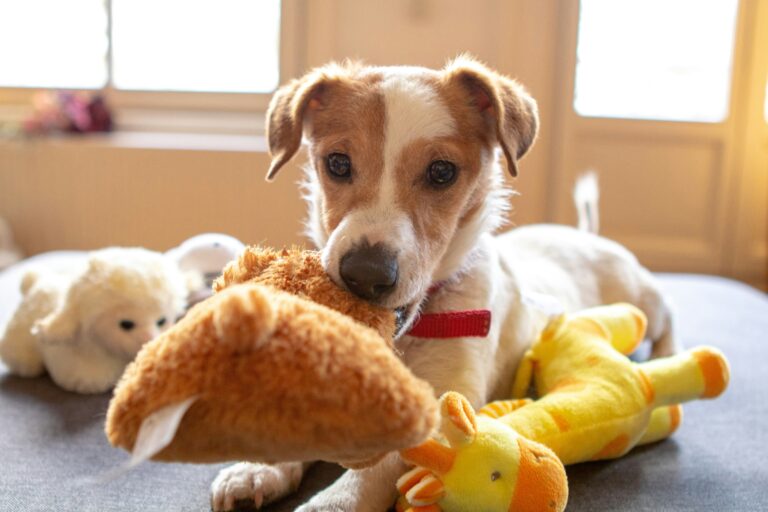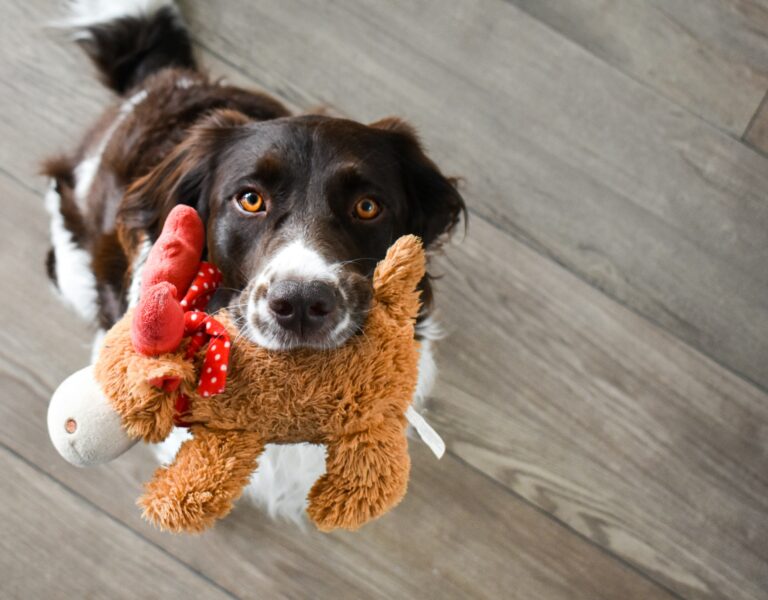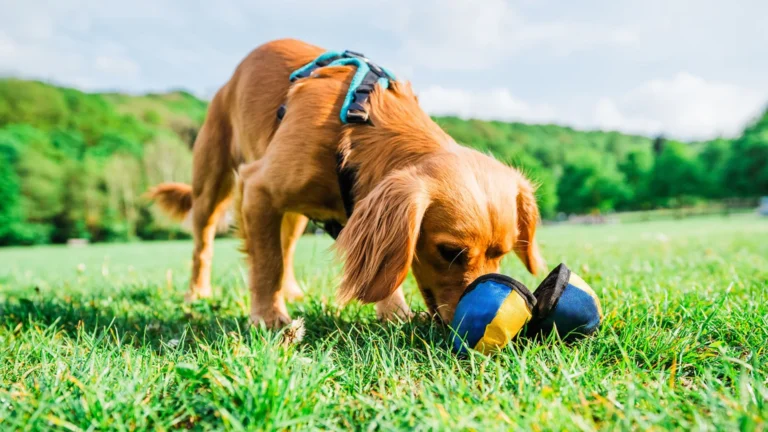Welcome to “Pawsitively Perfect: Top Toys for Senior Small Dogs to Keep Them Happy and Active!” This piece is set to be an invaluable resource for pet owners in search of the best playthings to keep their beloved senior small dogs engaged, happy and active. In this comprehensive guide, we will take a closer look at the range of toys available that are specifically designed for senior small dogs. These toys not only provide entertainment but also cater to the unique needs of aging canines. From the most stimulating to the most comforting toys, we’ve researched the top options that your furry friend is bound to love. We’ll delve into the benefits these toys provide, such as promoting physical activity and mental stimulation, which can significantly improve the overall well-being of your senior small dog. Moreover, we’ll also shed light on the factors to consider when choosing the right toys, including their safety, durability, and suitability for your dog’s age and size. Stay tuned as we present the top-notch toys in the market that will surely make your senior small dog’s tail wag with joy. Get ready to discover how these toys can contribute to your pet’s happiness and active lifestyle in their golden years. 🐾🐕🦴

The Importance of Low-Impact Play
As dogs age, their energy levels tend to decrease, and their joints may become more fragile. While they may not be able to chase balls at full speed anymore, senior dogs still benefit greatly from low-impact play. Toys that roll gently, squeak softly, or offer easy-to-access treats are ideal for providing entertainment without causing strain.
Toys that can be played with while lying down or sitting are especially helpful. These allow your dog to interact and enjoy stimulation without excessive physical effort. Additionally, toys with soft textures or plush exteriors are ideal for comfort and chewing without causing discomfort or aggravating dental issues.
Comfort Toys for Senior Dogs
Comfort becomes a priority as dogs grow older. Many senior small dogs enjoy having a soft companion toy to cuddle with, especially when resting or sleeping. Plush toys that are small enough to carry but big enough to snuggle offer emotional comfort and can help reduce anxiety.
These toys are especially valuable for dogs that experience separation anxiety or changes in routine. Having a familiar toy with a soothing texture can be reassuring, particularly in stressful situations like thunderstorms or vet visits. Some comfort toys are even infused with calming scents or have pockets for heating pads to provide extra warmth and coziness.
Scent-Driven Toys and Sensory Stimulation
For senior dogs that experience reduced vision or hearing, toys that rely on scent become incredibly useful. Dogs rely heavily on their sense of smell throughout their lives, and this sense remains strong even in old age. Toys infused with enticing scents like peanut butter, bacon, or chicken can attract attention and keep them engaged.
Some toys are designed specifically to hold smelly treats or include scent-dispensing mechanisms that gradually release smells as your dog interacts with the toy. These types of toys are mentally stimulating and encourage natural foraging behaviors that can provide hours of gentle, satisfying play.
Interactive Toys for Mind Stimulation
Interactive toys are an excellent way to challenge your senior dog’s brain. Simple puzzles with compartments for treats, rotating disks, or sliding covers can help maintain cognitive function. These toys encourage problem-solving and allow dogs to work for their rewards, which can be very satisfying for them.
It’s important to choose puzzles that are not too complex for older dogs. The goal is to offer stimulation without frustration. Start with simpler puzzles and increase complexity gradually based on your dog’s interest and ability. Interactive toys also help extend mealtime by turning it into a fun, enriching activity.
Sound-Activated and Light-Up Toys
For dogs with limited vision or hearing, toys that use alternate cues can be incredibly engaging. Sound-activated toys can stimulate dogs with reduced eyesight, while light-up toys can attract dogs with diminished hearing.
Some toys respond to touch or movement by playing sounds or flashing lights, which can help trigger interaction. These types of toys are especially useful during solo play or when the owner is unavailable to engage directly with the pet. Make sure these features are gentle and not overstimulating, as senior dogs may be more sensitive to sudden or loud noises.
Slow Feeders and Treat Dispensers
Senior dogs often benefit from slow eating, especially if they have digestive sensitivities or tend to overeat. Toys that double as slow feeders or treat dispensers can help manage portions and keep your dog entertained during mealtime. These toys typically have grooves or compartments that require dogs to work for their food, which adds mental stimulation and slows down their eating pace.
Treat-dispensing toys are also great for dogs that are alone during parts of the day. You can fill them with their favorite kibble or treats and let them work to retrieve the food, giving them a fun task that occupies their time and reduces boredom.
Toys to Encourage Gentle Exercise
While intense activity may no longer be suitable for senior small dogs, gentle movement is essential to keep their muscles active and joints flexible. Lightweight toys that roll slowly or toys designed for gentle tug-of-war games can promote mobility without risking injury.
Toys like rolling balls that move gradually on the floor or soft frisbees with easy grips help promote mild activity in a safe and enjoyable way. Incorporating short, supervised play sessions into the day can help your dog stay agile and improve their mood.
Chew Toys for Dental Health
Dental care is a common concern for senior dogs. While they may not be able to chew as aggressively as they once did, they still need to maintain oral hygiene. Soft rubber toys with textured surfaces can massage the gums and help remove plaque buildup.
Chew toys made of softer materials or designed specifically for older dogs are ideal. Some are flavored to keep your dog interested without being too hard on their teeth. Regular chewing can support dental health, reduce tartar buildup, and even freshen breath, making it an important activity in your senior dog’s routine.
Choosing Safe and Non-Toxic Materials
Safety becomes even more crucial for senior dogs. Their immune systems may be more sensitive, and they are more vulnerable to injury or illness from ingesting unsafe materials. When choosing toys, look for those labeled as non-toxic, BPA-free, and made without harmful chemicals.
Avoid toys with small detachable parts that can be swallowed or materials that are too hard and might crack teeth. Always inspect toys regularly for wear and tear, especially if your dog tends to chew a lot. Replacing damaged toys promptly can prevent potential accidents.
Portable Toys for Travel and Comfort
Many senior small dogs enjoy accompanying their owners on outings, whether it’s a car ride, a trip to the park, or a visit to a friend’s house. Lightweight and portable toys can provide comfort and entertainment on the go. Choose toys that are easy to pack, clean, and use in different settings.
Bringing along a familiar toy can also reduce anxiety in new environments. It gives your dog a sense of familiarity and helps them adjust to different situations more easily. Soft plush toys, small chew toys, or interactive puzzles that don’t require much space are perfect for travel.
Incorporating Toys Into Daily Routines
For the best results, integrate toys into your senior dog’s daily schedule. Rotate toys regularly to keep their interest high, and introduce new ones gradually. Allow your dog time to explore and engage with each toy at their own pace, especially when it offers a new texture or challenge.
Daily play, even if it’s brief, offers structure and joy to a senior dog’s life. Use toys during meal times, after naps, or before bedtime to create consistent routines. Not only do toys help pass the time, but they also enhance your dog’s mood and overall sense of well-being.
The Value of Human Interaction in Play
While toys are essential, your companionship is irreplaceable. Engaging with your senior dog during play enhances your bond and reassures them of your presence. Even a simple game with a soft toy or a gentle tug session can bring immense happiness.
Shared play encourages trust, reduces anxiety, and creates positive emotional experiences. It’s also a great way to monitor your dog’s health and detect any changes in behavior or ability. Incorporating a few minutes of interactive play into your day can make a significant difference in your senior dog’s life.
Toys as Tools for Enrichment and Longevity
Ultimately, toys play a vital role in improving the quality of life for senior small dogs. They are more than just sources of amusement; they help preserve mobility, cognitive function, and emotional stability. Regular playtime contributes to a longer, healthier life and helps maintain a sense of purpose and engagement.
Nina Ottosson by Outward Hound Puzzle Game Dog Toy
Nina Ottosson’s puzzle games are perfect for stimulating your pet’s mind. These toys challenge dogs to unlock treats through various mechanisms, keeping them mentally engaged. They’re also designed with non-slip bases and easy-to-clean compartments.
Planet Dog Orbee-Tuff Snoop
The Orbee-Tuff Snoop from Planet Dog is a treat-dispensing toy that challenges your pet to retrieve snacks from its interior. Its durable, non-toxic material makes it safe for senior dogs, while its translucent and pliable design adds intrigue for your furry friend.
Tips for Choosing the Right Toy
When picking a toy for your senior small dog, it’s crucial to keep a few factors in mind.
Consider Your Dog’s Current Health
It’s essential to think about your dog’s physical health when selecting a toy. For dogs with dental issues, soft toys are more suitable. Similarly, if your dog has mobility problems, opt for toys that don’t require too much physical exertion.
Keep Your Dog’s Preferences in Mind
Not all dogs enjoy the same types of toys. Some may prefer puzzle toys while others might enjoy squeaky toys. Observe your dog’s play habits to identify the types of toys they enjoy most.

Quality Over Quantity
It’s better to invest in a few high-quality toys rather than a multitude of cheaper ones. High-quality toys last longer and are generally safer, making them a better investment in the long run.
Conclusion
In conclusion, it is crucial to understand that senior small dogs require extra attention and care to maintain their physical health and mental wellbeing. Pawsitively Perfect offers an exceptional variety of toys that help keep these adorable pets happy and active. Regular play with these toys can significantly enhance their quality of life, stimulate their minds, and strengthen their physical capabilities. However, it’s not just about buying the toys; it’s about spending quality time with your beloved pet, enriching your bond, and keeping them engaged. These toys are not a replacement for love, affection, and companionship, but rather tools that assist in fostering a closer connection.
Therefore, ensure you incorporate regular playtime in your senior small dog’s routine. This consistent interaction not only encourages movement but also builds trust and emotional security, which are essential as dogs grow older. Investing in toys that suit their specific needs can help alleviate common age-related issues such as joint stiffness, anxiety, and cognitive decline.
Pawsitively Perfect‘s top toys are an essential investment in your pet’s happiness and health. They cater to various needs, providing entertainment, companionship, and exercise. Not only do these toys help combat boredom, but they also promote an active lifestyle, which is vital for your pet’s overall health. So, give your senior small dog the love and care they deserve with thoughtfully chosen toys that truly make a difference. 🐾🐕🧡
Remember, the joy and fulfillment they bring to your life are indeed Pawsitively Perfect! 🐾🐕🧡



